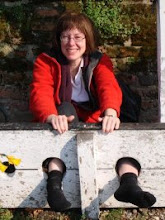
It is useful to trace quilt motifs and quilting layouts. Accurate full size tracings are more useful than sketches and here is the way I have traced many of my antique quilts. It does help you to really look at the patterns - and can also make the patterns more apparent - they are sometimes hard to see, especially in a very old or worn quilt, one with heavy quilting or a patchwork quilt.
First put the quilt on a large flat table with good lighting. A side light or torch helps to pick out t he quilting. Then lay over the quilt a sheet of medium weight polythene sheeting. This is available at DIY shops (plastic dustsheets) or in garden centres (poly tunnel sheeting). Avoid the light weight polythene as it is too flimsy and may puncture. As my quilts are whole cloth, I usually trace one quarter or one half, and include the central motif in full. Lay out the quilt, weighting it in place if necessary so that it does not slip off the table. Then pin the sheeting in place (this probably would not be allowed in museums).The plastic creeps and shifts if not held in place - if you cannot pin, books or other weights may suffice. Now carefully trace the pattern with a CD marker or other instant drying black marker - I found Sharpie brand markers to be excellent.
Trace motifs - backgound infill need not be drawn in full - just include a sample. Mark in the edges and any seams. Mistakes - mark the mistake with small tics and redraw the correct line. Q tips soaked in alcohol can erase the mistake later. This process is a bit tedious - so take your time. I leave the quilt out and have several sessions over subsequent evenings. Cats must be kept away from nice quilted area!!
With my Welsh quilts - it is fairly obvious from the tracing process that the quilters marked in the major fields and then the large motifs were marked in chalk - then the outlining and scrolling were done freehand. Often motifs on one end are different to those on the other end - the quilter was working fast and did not inspect the rolled up end as she worked from one end to the other on the frame. In Welsh quilts, grids are often wonky, straight lines are not really straight and the quilter often improvises if she runs out of room.
By contrast - the stamped (marked) Durham quilts have infill that is expertly drawn on, the motifs are clearly marked on, although done fairly freely. The whole is very symmetrical as the top was marked on large worktops.
Take care with these tracings - the plastic does “frizzle” if placed next to radiators or hot water pipes. And the ink can rub off onto cloth, so if tracing onto cloth, make sure that the inked side is face downwards. The tracings can be used as templates, but must be redrawn as age does tend to pucker and distort the quilts.
Label your tracing carefully with date, provenance, colour, size and any useful information. Store carefully in a folder or a mailing tube.
I include a photo of the Margaret Williams quilt with its tracing overlain.

Fascinating insight; thanks for sharing this method.
ReplyDeleteWonderful idea-thank you for sharing this.
ReplyDeleteI like to lay two sheets of plastic over the quilt and draw on the top one. Just in case there is the tiniest of invisible blemishes in your plastic and your Sharpie marks the quilt top. I'm a belt, braces *and* a piece of string type person
ReplyDelete